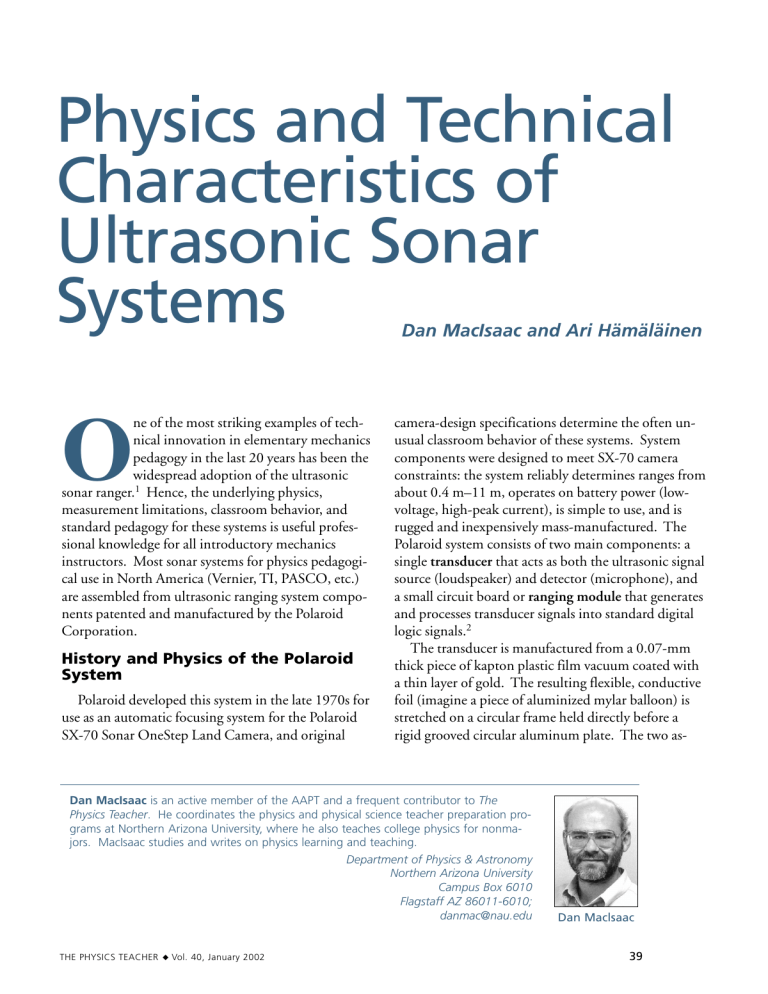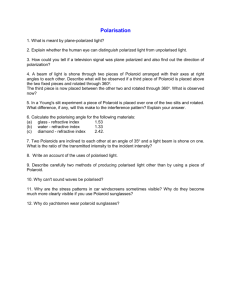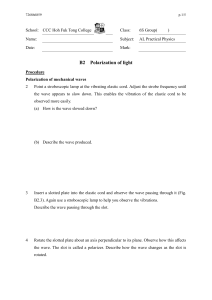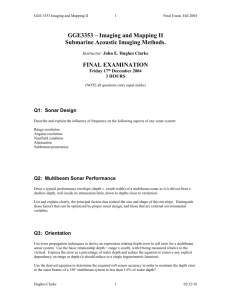Physics and Technical Characteristics of Ultrasonic Sonar Systems
advertisement

Physics and Technical Characteristics of Ultrasonic Sonar Systems Dan MacIsaac and Ari Hämäläinen ne of the most striking examples of technical innovation in elementary mechanics pedagogy in the last 20 years has been the widespread adoption of the ultrasonic sonar ranger.1 Hence, the underlying physics, measurement limitations, classroom behavior, and standard pedagogy for these systems is useful professional knowledge for all introductory mechanics instructors. Most sonar systems for physics pedagogical use in North America (Vernier, TI, PASCO, etc.) are assembled from ultrasonic ranging system components patented and manufactured by the Polaroid Corporation. O History and Physics of the Polaroid System Polaroid developed this system in the late 1970s for use as an automatic focusing system for the Polaroid SX-70 Sonar OneStep Land Camera, and original camera-design specifications determine the often unusual classroom behavior of these systems. System components were designed to meet SX-70 camera constraints: the system reliably determines ranges from about 0.4 m–11 m, operates on battery power (lowvoltage, high-peak current), is simple to use, and is rugged and inexpensively mass-manufactured. The Polaroid system consists of two main components: a single transducer that acts as both the ultrasonic signal source (loudspeaker) and detector (microphone), and a small circuit board or ranging module that generates and processes transducer signals into standard digital logic signals.2 The transducer is manufactured from a 0.07-mm thick piece of kapton plastic film vacuum coated with a thin layer of gold. The resulting flexible, conductive foil (imagine a piece of aluminized mylar balloon) is stretched on a circular frame held directly before a rigid grooved circular aluminum plate. The two as- Dan MacIsaac is an active member of the AAPT and a frequent contributor to The Physics Teacher. He coordinates the physics and physical science teacher preparation programs at Northern Arizona University, where he also teaches college physics for nonmajors. MacIsaac studies and writes on physics learning and teaching. Department of Physics & Astronomy Northern Arizona University Campus Box 6010 Flagstaff AZ 86011-6010; danmac@nau.edu THE PHYSICS TEACHER ◆ Vol. 40, January 2002 Dan Maclsaac 39 semble as the two plates of a parallel plate capacitor, where the aluminum plate is quite rigid and the kapton foil plate is highly flexible (Fig. 1). When a high-voltage signal (a 49.4-kHz square wave at 300 to 400 V) is applied to the transducer assembly, the foil is driven back and forth by electrostatic forces creating ultrasonic pressure waves in the air. These waves are directed outward from the transducer in a characteristic beam pattern (Fig. 2) to strike the target being ranged. The transducer is also operated as a microphone; returning reflected pulses physically move the foil, and this motion can be detected as a change in transducer capacitance. This foil capacitor arrangement is one of several systems capable of producing and detecting ultrasound — ordinary audio-speaker cones cannot mechanically respond at these frequencies. The ranging module requires a 5-V supply capable of short (1-ms) current surges of up to 2.5 A. The ranging module transmitting circuitry accepts a digital command signal from a computer or calculator to transmit a pulse, then creates a “pulse train” of sixteen 5-V 49.4-kHz square-wave pulses. These low-voltage, high-current pulses are then sent through a step-up transformer to supply the transducer with low current, 300- to 400-V pulses. The transducer foil mechanically moves, converting the electrical pulse train to ultrasound and transmitting it outward from the front of the transducer housing. After transmitting the pulse train, the transmitter circuitry shuts down, and receiving circuitry is turned on to monitor the capacitance of the transducer. The interface or calculator that is running the transducer starts an elapsed-time clock simultaneous to pulse transmission. At the target, the ultrasound pulse train is partially reflected and partially absorbed, then returns (greatly attenuated) to the transducer. The receiver detects a Fig. 1. Polaroid electrostatic-transducer assembly. (Original art permission of Polaroid Corp.) note: db normalized to on-axis response Fig. 2. Polaroid electrostatic-transducer transmission beam pattern in 2D. Note the central lobe defines a 30º wide “detection cone” for the ranger. (Original art permission of Polaroid Corp.) change in transducer capacitance, and the ranging module reports to the computer via a digital signal that a signal echo has been received. Upon receipt of this digital signal by the computer, the elapsed-time clock is stopped. The elapsed time (⌬t) is used along Ari Hämäläinen received his M.S. (1986) and Ph.D. (1998) degrees in physics from the University of Helsinki. After two years as a schoolteacher, he is now a lecturer at the University of Helsinki in the teacher education program. He teaches the laboratory course, and researches the utilization and implementation of microcomputer-based laboratory techniques in physics teaching. Department of Physics University of Helsinki, Finland; aohamala@cc.helsinki.fi Ari Hämäläinen 40 THE PHYSICS TEACHER ◆ Vol. 40, January 2002 with the known speed of sound vs to generate a roundtrip travel distance using the relation d = vs⌬t. Half this round-trip distance (d/2) is the range to the target. At a pressure of 1 atm, the speed of sound is given by vs = (331.0 + 0.6 T) m/s, where T is temperature in degrees Celsius; so in a 20⬚C room typically vs = 342 m/s. For example, when a computer measures ⌬t equal to 10 mS, this corresponds to a range of about 1.71 m, calculated as: d = vs⌬t = (342 m/s) (10 x 10-3 s) = 3.42 m. Then the one-way range is r = d /2 = (3.42 / 2) m = 1.71 m. A handy off-the-cuff figure for this kind of problem is that sound travels about a third of a meter every millisecond, or one meter every three milliseconds. Blind Spots and Buzzing Sounds Immediately after transmitting the pulse train via the transducer, the transmitter circuitry shuts down. The receiving circuitry for this same transducer is then turned on, but only after a short time delay. This is necessitated by the fact that the foil, after transmitting the pulse train, continues to vibrate (or “ring”) for a brief period and must be allowed to self-damp sufficiently so that its motion is less than that produced by the reception of an echo pulse. Otherwise, residual ringing from the previous transmission would be mistakenly detected as a return pulse. (Due to atmospheric absorption, partial target reflection, and the inverse square law, the returning ultrasonic echo is attenuated by a factor of more than 106 compared to the transmitted signal)2. This problem was solved in the original camera design by simply not turning on the receiving circuitry until a delay of 2.38 ms passed, which is plenty of time for the foil to mechanically damp down under most circumstances. This is a very inexpensive solution that in no way interfered with the original camera design — closer focus was not possible with SX-70 cameras. This 2.38-ms blanking interval corresponds to a round-trip distance of 81 cm by the calculation d = vs⌬t = (342 m/s) (2.38 x 10-3 s) = 0.81 m = 81 cm. Half this number (40.5 cm or about 1.3 ft) corresponds to a one-way minimum range below which the standard Polaroid ranging module cannot detect a returning pulse. The standard system is therefore “blind” for the first 2.38 ms after pulse transmission or within the closest 40.5 cm directly before the trans- THE PHYSICS TEACHER ◆ Vol. 40, January 2002 ducer. This blind spot presents considerable pedagogical difficulties if working with an object that approaches from a greater distance to one less than 41 cm before the transducer. The object apparently “disappears” or jumps on a computer-generated distance plot. This effect is magnified when looking at data derived from position data (velocity and acceleration) that are sensitive to position discontinuities. Over the last 20 years, advances in foil manufacture and the use of a continuous 150 to 200 V dc bias voltage on the transducer plates have greatly improved the damping of the Polaroid transducer foil. Although the default setting for the blanking interval between transmission and receiver activation is still 2.38 ms for all Polaroid ranging modules to ensure compatibility, newer hardware versions can achieve shorter blanking intervals. Polaroid has added a digital signal input on the ranging module that allows the module purchaser to add external circuitry to control the blanking interval, and reducing this interval below 2.38 ms reduces the size of the blind spot. It is possible to reduce the blind spot to about 15 cm (6 in) by adding such timing circuitry. This is the present limit possible with these components, and some manufacturers have recently released such modified rangers (e.g., PASCO). Hence, the standard Polaroid ranger blind spot can be reduced but not eliminated by extra effort, and this improvement is becoming a standard design element by physics education apparatus suppliers. Because of different ranges and target characteristics that occur in typical use, there are tremendous variations in return acoustical signal strength. This requires that the ranging module use return-pulse detection followed by a lock-on through an automatic gain circuit. To achieve this lock-on, the return signal must include several repetitions (16 pulses) of a well-defined frequency (49.4 kHz). Hence, the Polaroid system uses a pulse train of 16 sonar pulses rather than a single ranging pulse. Human ears can easily hear the start of any single pulse train as a sharp strong click, although our ears cannot react quickly enough to hear the individual ultrasound pulses. We hear the ultrasonic pulse train, but not the individual cars. Typical pedagogical systems use sample rates of about 50 Hz — that is, they transmit and receive 50 separate pulse trains per second, determining target range 50 times a second. This sampling rate is clearly not ultrasonic, but the 41 transmission of these pulse trains one after the other is heard as a 50-Hz buzz. Oftentimes (e.g., near a smooth, close wall) reflected pulse echoes from the system are also audible. Resolution, Precision and Accuracy of the System One of the most important issues with the use of measurement technology in the classroom is evaluating the data — assessing when the measurements are true data and when data contains artifacts created by the measurement system. Student instruction via measurement technology must include the ability to critically appraise when the technology is producing a genuine representation of a phenomenon, and when “instrumental effects” or noise dominate or mask “real” data.3 Distance measurements made with the Polaroid system can be characterized by their accuracy (how well they compare to a known standard), precision (selfconsistency, or how well they repeat), and resolution (the minimum detectable change). For all common pedagogically used Polaroid systems, these last two figures are ultimately determined by the finest interval discriminated by the elapsed-time clock used by the device controlling the Polaroid ranging board. For example, the Vernier ULI uses the standard Polaroid transducer and module, and an internal clock running at 1.00 MHz. This clock interval corresponds to a time interval of ⌬t = 10-6 s and therefore a distance of: ⌬d = vs⌬t = (342 m/s) (1.0 x 10-6 s) = 3.42 x 10-4 m = 0.34 mm; ⌬r = ⌬d / 2 = 0.17 mm. According to the Nyquist sampling theorem,4 this measure is actually half the smallest resolvable interval, so resolution is at best about a third of a millimeter. Our measurements of ULI resolution (0.345 mm) confirm this number; Vernier claims a practical ULI sonar resolution of 1.1 mm (almost four times rougher). In practice, resolution is strongly affected by multiple echoes, but theory and practice with the ULI agree that an ultimate resolution of a third of a millimeter is appropriate given a strong, clean reflection and a one-megahertz clock. Precision (self-repeatability) of an ultrasonic ranging system can be measured by repeatedly taking range data on a stationary target and calculating the standard error of measurement of the distances measured by the system. We have carried this out with a Vernier ULIII 42 system and find that quantity to be 0.2 mm, with a maximum error of 0.31 mm, which also corresponds to the resolution of the system. As a general rule of thumb, the position precision and resolution of most Polaroid-derived systems for physics pedagogy should not be safely trusted to be much better than a millimeter, with a third of a millimeter as the absolute limit requiring very carefully controlled conditions. The accuracy (match to a meterstick) of positions reported by these systems is almost solely a function of proper calibration, and usually sonar position-measurement ac- curacy cannot be trusted at all without calibration, though with thorough, recent calibration one-millimeter position accuracy is also achievable. Since velocity and acceleration are calculated from changes in position (not absolute position), velocity and acceleration measurements do not require calibration. However, measurement uncertainties propagate when simple algorithms5 are used to calculate velocity and acceleration from position data, so most pedagogic sonar software defaults to showing “noisy” velocity and noisier acceleration data in typical use. For instance, in a typical laboratory situation using an inclined airtrack, three position measurements were obtained with uncertainties of only 0.06% each.5 But if these data are taken near a zero-velocity point (as when a glider coasts to a halt and reverses direction under the influence of gravity), they will result in two calculated average velocity values having up to 7% uncertainty each. We have seen situations where this uncertainty finally propagated to a single average acceleration measurement with final uncertainty (displayed as “noise”) of 30%. This noise issue can be addressed by multipoint averaging (which introduces other distortions in velocity and acceleration data, e.g., delaying the exact time of a rapid change in position such as a glider “bounce”) or preferably by modeling the data through statistically fitting an equation to the data. Advanced methods for calculating less noisy velocity and acceleration data from sonar position data yield better data at the expense of a higher student cognitive load and hence are not defaults in most software. Two wellfounded curricula that use equation modeling to fit data include Laws’ Workshop Physics and Hestenes’ Modeling Physics.6,7 Ultimately, sonar sampling speed and uncertainty limits make the study of fast phenomena like impulse curves during collisions better performed by force probes using strain gauge technology. THE PHYSICS TEACHER ◆ Vol. 40, January 2002 Distance vs Time Velocity vs Time Fig. 3. Blind spot including multiple reflections. Common Classroom Difficulties Situation #1: The blind spot and multiple reflections The blind spot is unavoidable without electronically modifying the Polaroid sonar system. Therefore, the only practical means for avoiding this is (unfortunately): do not let the moving object come too near the sensor. Figure 3 shows uniformly accelerated motion of a reflector-equipped PASCO glider on an airDistance vs Time Velocity vs Time track. The glider was launched from within the blind spot, 20 cm from the sensor. Sensor data from 0.0 s to 0.3 s are distorted by the blind spot. In this plot, from 1.7 s to 2.3 s, the sensor falsely reports8 distances that are exactly twice the actual separation between the sensor and the reflector due to a multiple reflection. In this region, the ultrasonic pulses reflect both from the reflector and the sensor, and travel the range distance four times before detection. Such discontinuities in position plots result in the calculation of erratic velocity and acceleration data. Such multiple-reflection situations most commonly occur when measuring vertical free fall (determination of g or air resistance), when pulses bounce between floor and ceiling, or with an airtrack set up in a small room near and perpendicular to a smooth wall. If pulse bouncing between surfaces is suspected, try the following: a) move the sensor and the object closer together, b) move the sensor along the line of measurement, c) relocate the line of measurement so that it is not perpendicular to the reflecting planes, d) alter the data rate (both decreasing and increasing the rate may help), or e) cover one or both of the surfaces with sound-absorbing cloth or other material. A nice way to implement this last trick is to pull an ordinary sock over the ranger whenever working at close ranges; this looks odd but almost always cleans up the signal by damping multiple-reflection signal strength and attenuating transducer side lobe sensitivity (Fig. 2). Distance vs Time Velocity vs Time Fig. 4. Effects of adding a 5 x 6-cm reflector to the transducer-facing end of an airtrack glider. THE PHYSICS TEACHER ◆ Vol. 40, January 2002 43 Situation #2: Getting a clear, consistent reflection Frequently the target object does not produce a consistently clear, strong reflection from a single area. For instance, students are often asked to obtain kinematic data from their own body motions before the ranger. Fuzzy sweaters produce very poor reflections, and holding a textbook or lab manual in front of the body will improve the signal and data. Tennis balls are often difficult to track for the same reason; try a smoother-surfaced ball instead. Objects that rotate, flutter, or tilt as they move will provide reflections from different areas, yielding false data for the centerof-mass motion. A solution is to use a spherically symmetrical object like a basketball for obtaining such data. Adding a “sail” or “flag” reflector to the transducerfacing end of an airtrack glider or low-friction wheeled cart greatly improves return signals, and it is even possible to construct sonar “corner reflectors” to provide strong signals (see Fig. 4).9 Situation #3: Obstructions and unwanted reflections The sonar sensor detects the position of the closest object that provides a reflection intense enough to trigger the receiver circuitry. If there is an obstacle within the cone of detection that is nearer the sensor than the moving object, then the sensor sees the obstacle, not the moving object. The result is that the sensor seems not to be able to measure beyond a certain distance. To correct this problem, first clear unwanted objects from the sonar beam, which is approximately 30⬚ wide but has additional close lobes (see Fig. 2). Look for and remove pencils, books, calculators, airtrack supports, etc. Sometimes it is also possible to aim the ranger to exclude fixed obstructions from the cone of detection. Figure 5 shows the effect of an airtrack support obstructing a sonar ranger just beyond 1.5 m. Situation #4: External noise External sound that is both loud enough and that contains transducer-sensitive frequencies may cause the receiver circuit to be falsely triggered and lead to noisy data. We have observed this (see Fig. 6) with airtracks and their air supplies due to high-pitched whistling. The presence of this noise can be confirmed by turning off the supply. To reduce it, turn down the supply or place it under the table or shield it. You can 44 Distance vs Time Fig. 5. Beam obstructed a little beyond 1.5 m. also shield the transducer from direct airflow from airtrack holes with a small piece of cardboard. Frequently computer monitors and (rarely) fluorescent-light ballasts produce 50-kHz noise that can interfere with the ranger as well. Move away from computer monitors and test your rangers in another room if you suspect these latter problems. Other Pedagogical Ranging Systems Currently available versions of non-Polaroid sonar systems typically contain two units, an ultrasonic receiver and a transmitter (Fig. 7). The fixed sonar receiver is connected to a computer, and when operated by the computer an elapsed-time clock is started and an IR pulse is sent from the sonar receiver to the batterypowered sonar transmitter. The IR pulse is effectively instantaneously received and causes a single sonar click to be emitted by the sonar transmitter. When the receiver stops the clock, range is determined by soundpulse travel time. The sonar transmitter is very simple and usually powered by a long-life battery. This system has no blind spot, and neither the surface nor the shape of the ranged object is important. However, attaching and aiming the transmitter can be difficult. A sophisticated IR/sonar ranger system, the VScope is unique in that it uses three spatially separated IR/sonar stations (originally located in separate towers, now in a fixed geometry) transmitting coded IR pulses to up to four conveniently small sonar transmitter buttons. The coded IR signal selects one of the buttons to send a pulse, which when received by the three receivers fixes the button location in three dimensions THE PHYSICS TEACHER ◆ Vol. 40, January 2002 Fig. 6. Effects of air noise from PASCO #SF-9216 Variable Output Air Supply on Polaroid sonar data. by triangulation. Although it is possible to track multiple buttons (in turn) in three spatial dimensions with the V-Scope and MotionCall10 systems, one trades cost and flexibility for this feature. More importantly, the outstanding curricular materials developed for teaching introductory mechanics with Polaroid-style systems are unfortunately absent for this system. Nonetheless, advanced analyses of tabletop scale complex motions via IR/sonar systems are possible. The future of advanced analysis appears to lie in video — video systems for the pedagogical analysis of 2-D mechanical motion are readily available and 3-D systems involving multiple cameras are in development.11 ultrasonic transmitter ultrasonic receiver transmitter unit infrared receiver Fig. 7. Simple IR/sonar ranging system. THE PHYSICS TEACHER ◆ Vol. 40, January 2002 infrared transmitter Sonar Pedagogy The use of sonar, microcomputer-based laboratory (MBL) interfaces and similar technologies have revolutionized physics teaching in the last 20 years, and have been thoroughly researched and reported.12 In a sense, technology has been a “Trojan horse,” supplying a professionally attractive and politically popular impetus that challenged long-entrenched teaching practices. Technology facilitates convenient, rapid collection and display of quality physical data,13 but research indicates that profound student learning actually takes place through the synergy of technology with studentcentered curricula that foster student interpretation, negotiation, and dialogue about these motion data. In these curricula, students acreceiver unit tively interpret slopes, intercepts, zero values, critical points, areas, and discontinuities on motion graphs, and create associations between these graphic events, the physical events measured, and theo45 ry.12 To be effective, student interpretation should be explicitly verbalized and reinforced through discussion and writing in the students’ own words and within their own lived experiences.14 Some sonar-using curricula that guide and support these practices include Workshop Physics, RealTime Physics, and Modeling Physics.6,15,7 Student-centered physics curricula not explicitly reliant upon sonar technology for the presentation and analysis of similar motion data include Physics by Inquiry, MindsOn Physics and Physics: A Contemporary Perspective.16 Technology alone appears insufficient for profound, worthwhile change in physics learning and teaching14; a well-founded research-based and student-centered physics curriculum is necessary to achieve significant changes in student learning. 5. 6. 7. 8. 9. 10. Acknowledgments We would like to thank David Vernier of Vernier Software; Phil Jackman, Applications Manager OEM Components Group at Polaroid Corporation; Edward I. Shibata and Mike Zimmerman of Purdue University; and an anonymous referee for their valuable comments, advice, and assistance. 11. 12. References 1. 2. 3. 4. See B. Duchesne, C. W. Fischer, and C.G. Gray, “Inexpensive and accurate position tracking with an ultrasonic ranging module and a personal computer,” Am. J. Phys. 59 (11), 998–1002 (Nov. 1991); T.B. Greenslade, “Experiments with ultrasonic transducers,” Phys. Teach. 32, 392–398 (Oct. 1994); T.B. Greenslade and J.A. Mason, “Ultrasonic interferometers,” Phys. Teach. 36, 249–252 (April 1998); R.A. Cline and J.S. Risley, “A comparison of sonic rangers for demonstrations and experiments in mechanics,” Phys. Teach. 26, 46–49 (Jan. 1998); I.R. Gatland, “Product review: The Daedalon ultrasonic measurement system,” Comput. Phys. 5 (5), 541 (Sept./Oct. 1991). Polaroid Corp. Polaroid ultrasonic ranging products and reference materials at http://www.polaroidoem.com/ products/ultrasonic.htm. Polaroid ultrasonic ranging system handbook: Application notes/technical papers (Polaroid, Cambridge, MA, 1983); Polaroid ultrasonic ranging system (Polaroid, Cambridge, MA, 1992); and Polaroid ultrasonic components (Polaroid, Cambridge, MA, 1997). R. Nachmias and M.C. Linn, “Evaluations of science laboratory data: The role of computer-presented information,” J. Res. Sci. Teach. 24, 491–506 (May 1987). Nyquist sampling is described at http://www.bores. com/courses/intro/ basics/1_alias.htm and in L. Wells, LabVIEW Student Edition User’s Guide (Prentice Hall, 46 13. 14. 15. 16. Englewood, NJ, 1995). A discussion of worst-case measurement uncertainty analysis and related issues for introductory students can be found at http://purcell.phy.nau.edu/pubs/ MeasurementAnalysis/. P.W. Laws, Workshop Physics Activity Guide (Wiley, New York, 1995). D. Hestenes, Modeling Physics. Mechanics curriculum freely available from http://modeling.asu.edu/ Curriculum.html as editable files. M. Ryan Avett et al., “Illusions for motion detectors,” Phys. Teach. 35, 174 (March 1997). R.A. Morse, “Simple corner reflectors improve data from sonic motion detectors,” Phys. Teach. 28, 423 (Sept. 1990). The V-Scope system is now sold by Intelitek, and is described at http://www.intelitek.com/products/ technology-training/teklinks/cda.html. See also M. Ronen and A. Lipman, “The V-Scope: An ‘oscilloscope’ for motion,” Phys. Teach. 29, 298–302 (May 1991); and H.A. Daw, “An assessment of the PASCO V-Scope,” Phys. Teach. 29, 304–309 (May 1991). 2-D video analysis systems are Worlds In Motion, http://members.aol.com/raacc/wim.html, and Videopoint, http://www.lsw.com/videopoint/. 3-D systems under development include Alberti’s Window, http://www.albertiswindow.com/. See, for instance, R.J. Beichner, “Testing student interpretation of kinematics graphs,” Am. J. Phys. 62, 750–762 (August 1994), H. Brasell, “The effect of realtime laboratory graphing on learning graphic representations of distance and velocity,” J. Res. Sci. Teach. 24, 385–395 (April 1987). A slightly dated overview of MBL pedagogy research is available at http://www.phy.nau.edu/~danmac/whyMBL.html. A. Hämäläinen, “An Open Microcomputer-Based Laboratory System for Perceptional Experimentality,” University of Helsinki, Report Series in Physics (University of Helsinki, 1998), HU-P-D70, ISSN 0356-0961, ISBN 951-458182-2; http://www.helsinki.fi/~aohamala/thesis/. D.L. MacIsaac, “The design and implementation of microcomputer-based laboratory instrumentation in the British Columbia high school chemistry curriculum,” M.A. dissertation, University of British Columbia, 1991; “Curricular reformation in computer-based undergraduate physics laboratories via action research,” Ph.D. dissertation, Purdue University, 1994. D.R. Sokoloff, R.K. Thornton, and P.W. Laws, RealTime Physics (Wiley, New York, 1998). E.g., L.C. McDermott, Physics by Inquiry, Vol. II (Wiley, New York, 1996); W.J. Leonard, R.J. Dufresne, W. J. Gerace, and J.P. Mestre, Motion: Minds-On Physics Activities and Reader (Kendall/Hunt, Dubuque, IA, 1997); R.D. Knight, Physics: A Contemporary Perspective (Addison-Wesley, Reading, MA, 1997). THE PHYSICS TEACHER ◆ Vol. 40, January 2002







